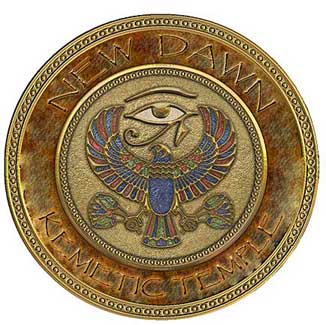|
|
|


~Mark Andrews~
The Egyptian god, Montu was an important falcon headed god
early in the history of the Thebean region. Not only was a temple dedicated
to him at Thebes, but also nearby in ancient Madu, today's Medamud about eight
kilometers northeast of Luxor. In addition, had cult centers at Armant, and
Tod.
While there was a Middle Kingdom temple built to the god, and possibly even
an earlier structure, it was destroyed. That temple was mainly built by Senusret
III, with perhaps additions by Nebhepetre Mentuhotep. Kings of the late Middle
Kingdom and 2nd Intermediate Period continued to build there, including Amenemhet
VII, Sebekhotep II and Sebekhotep III of the 13th Dynasty, and Sebekemzaf I
of the 17th Dynasty. We may also see some scattered remains of the New Kingdom
and Late Period. However, a ruined temple of the Graeco-Roman period survives,
which together with the war like god, Montu, is also dedicated to Rattawy (the
female counterpart of Re who is often depicted like Hathor as a cow with a sun
disk surmounting her head) and Harpocrates (Horus the Child). It is possible
it may have been built on the site of the older temple.
The main portal entrance was built by Tiberius, but its facade consists of an unusual triple portal formed by three kiosks of Ptolemy XII. In the southern kiosk, the screen walls were decorated with reliefs of singers and musicians along with a dancing goddess, Bes. The portal leads through the facade to a large peristyle courtyard, with an altar, which was embellished by Antoninus Pius. It in tern leads to a hypostyle hall built by Ptolemy VIII. Regrettably, only a few large columns, of various types, in the peristyle court built by Ptolemy VII and the outer part of the hypostyle hall are all that survive today. However, a granite doorway depicting Amenhotep II before Montu-re has also been preserved.
Behind the main sanctuary dedicated to Montu, his consort Rattawy and Harpocrates, is the smaller sanctuary of the sacred bull of Montu, with only a small section of exterior wall remaining. However, on one of these walls, a scene depicting the king (Trajan) worshipping the bull at the point were oracles were delivered is still visible. This small sanctuary probably included rooms for the living animal. Some of the walls within the main temple and the smaller Montu sanctuary show to have been decorated by the emperors Domitian and Trajan.
This temple is surrounded by an brick enclosure wall, also built by Tiberius, and within the wall was a sacred lake, a well and granaries. There once also stood a Ptolemaic chapel, built by Ptolemy II Philadelphus, Ptolemy III Euergetes I, and Ptolemy IV Phiopator, at the southwest corner of the wall, and processional way lined with sphinxes ran from the main temple entrance to a quay which stood on a canal linking this temple to the temple of Montu in the Karnak precinct. The temple's axis at Karnak faces this temple.
To the east of the temple precinct was a cemetery. A block field on the southern side of the temple is worth investigating as it contains many interesting fragmentary reliefs including a lintel of Ramesses III and the lower portion of a seated statue of Senusert I. However, much of this material did not come from this particular temple.
It should also be noted that a Christian church, perhaps dating as early as the 4th century was built within this temple. Its ruins are still traceable, and the remains of its pillars can still be seen. Unfortunately, these early Christians caused considerable damage to the temple reliefs, often carving out the faces of kings and deities alike.